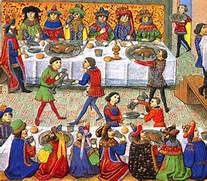Continuing
with my five-part series looking at how objective factors can cause
havoc for an unwary writer of historical fiction I look at cold. The
problem, as I noted at the beginning, is that even
these measurable and seemingly immutable physical factors impacted
people
differently in the past.
There is an old adage that there's no such thing as bad weather -- just the wrong clothes. The same could be said about housing. Eskimos have developed ways to deal with intense cold, enabling them to live in conditions the rest of us try to avoid. Furthermore, the exact same temperature can seem "chilly" to one person and "toasty" to another. Raised in Michigan and Maine but living many years in Africa, I always found it amusing when Africans would started wearing fur-trimmed parkas and gloves in weather I still found pleasant in a light jacket. When considering the impact of cold in the past, therefore, we need to consider not only the means of heating and dressing for cold, but also the fact that people may simply have been more "hardened" to cold than those of us pampered by central heating all our lives.
It is, for example, still assumed and alleged that women wore no underpants in the Middle Ages simply because we have no images of women wearing this garment. But then again, why would we? Saints, queens and ladies, obviously, were not going to be shown in their underwear, while pornographic images tended to prefer women completely undressed. The fact that we know about men's underwear is because laborers often stripped down to their braies while working in the summer heat; women didn't do that. That doesn't mean they didn't wear underwear, and recent discoveries in Germany of braies with very pretty embroidery suggest that, indeed, many braies we assumed to be men's wear might have been worn by women instead or as well. In short, there is inevitably much we don't know about what people wore to keep warm.
Similarly, because most of us encounter medieval life by visiting the ruins of castles, it is easy to forget that castles were not naked walls with the wind blowing through them. There were tapestries and wall hangings, carpets and rugs, and there were, if not glass windows, horn and parchment window coverings and shutters, sometimes inside and out. The equivalent of modern heating? Hardly, anything other than glass over the windows reduced the light, while anything short of double and triple glazing let in more cold than we are used to. Nevertheless, the temperatures in most castles were probably not as icy as you would think from reading many novels. If nothing else, most castles housed large numbers of people and they create their own heat!
 |
| Note the wall hangings and carpets. |
For readers tired of clichés and cartoons, award-winning novelist Helena P. Schrader offers nuanced insight to historical events and characters based on sound research and an understanding of human nature. Her complex and engaging characters bring history back to life as a means to better understand ourselves.








No comments:
Post a Comment